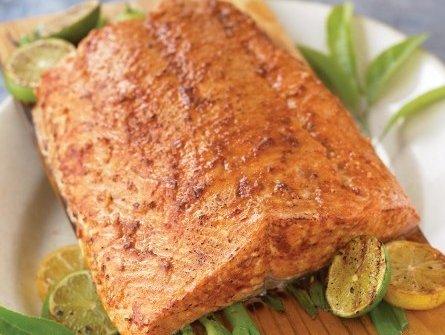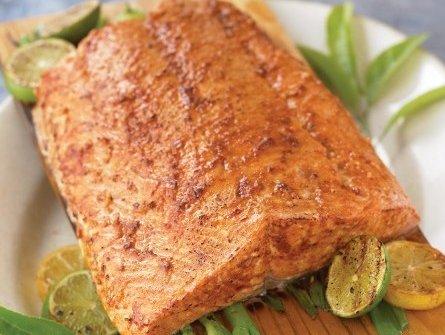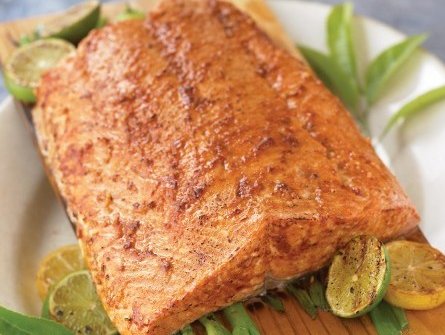My all-time favorite fish is fresh, wild-caught Alaska salmon. Granted, it can be on the pricey side, especially if you order it at a restaurant, but cooking salmon is actually quite easy.
There are five different species of Alaska salmon: king, sockeye, coho, keta, and pink. The most well-known and most abundant is the Alaska king salmon. It is a bit firmer in texture, so it can be put directly on the grill.
Another great way of cooking salmon is by using a plank of wood. Planks can usually be found in the meat department at specialty stores. It is very simple, and you will be awarded with a fillet of perfectly cooked fish.
At the high end of the salmon spectrum is Alaska sockeye, which has a deeper-red flesh color even when cooked, and a distinctive rich flavor. It is best cooked in an aluminum-foil tray—this is a foolproof way of cooking delicious fish.
Right now, sockeye salmon is in season. I have seen it advertised on sale throughout the summer, so this is the time to treat yourself.
Wild-caught salmon from the pristine, cool waters of Alaska is by far the best choice as opposed to farm-raised fish. Farm-raised fish are enclosed in commercially controlled tanks usually in lakes, ponds, rivers, and oceans. Due to their compact living conditions, the fish tend to have more diseases and toxins compared to wild-caught. As a result of their poor living conditions, fish are given antibiotics, which of course if eaten are passed down to you. Also, another great variable is the taste—wild-caught just taste better.
Salmon is nutritious as it is low in saturated fat and high in omega-3 fatty acids.
The following cooking techniques have been developed specifically for Alaska sockeye salmon.
Outdoor Grilling:
- Preheat grill to 375 degrees F.
- Remove Alaska sockeye salmon from refrigerator 15 minutes before cooking.
- Make a foil pan by cutting 2 pieces of wide, heavy-duty aluminum foil about 6 inches longer than the salmon side.
- Stack the foil pieces (shiny side down) on a baking sheet; spray generously with cooking spray.
- Place salmon, skin side down, in the middle of the foil.
- Fold the foil sides and ends up (1 to 2 inches) to make a shallow pan leaving at least a 1-inch margin around the fish.
- Season salmon with salt and pepper or favorite seasoning.
- If using a rub, let it rest on the salmon for 10 minutes before cooking.
- Transfer the foil pan to the center of the preheated grill.
- Close grill cover and cook for 10 to 13 minutes. Do not cover the salmon with foil or close the foil over the salmon.
- Do not flip the salmon.
- Cook just until salmon is lightly translucent in the center—it will finish cooking from retained heat.
- Remove salmon to a plate or platter and let it rest a few minutes before serving.
Indoor:
- Remove Alaska sockeye salmon from refrigerator 15 minutes before cooking.
- Heat a ridged grill pan over medium-high heat until hot (about 3 minutes).
- Drizzle a large dinner plate lightly with olive oil.
- Swipe each salmon portion through the oil (both sides) and place salmon in pan, skin side up.
- Cook for 3 minutes. Do not move it again until it is seared/browned.
- Flip fish, season with salt and pepper, and cook 3 minutes more.
- Cook just until salmon is lightly translucent in the center—it will finish cooking from retained heat.
- Remove salmon to a plate or platter and let it rest a few minutes before serving.
Alaska Sockeye Salmon With Herbs and Garlic
Makes 4 to 6 servings
- 1 1/2 pounds Alaska sockeye salmon
- Heavy-duty aluminum foil
- Cooking spray
- 1 1/2 teaspoons kosher salt
- 1/2 teaspoon freshly ground black pepper
- 1/2 cup white wine
- 2 tablespoons melted butter or extra-virgin olive oil
- 2 tablespoons finely minced fresh garlic
- 2 tablespoons chopped fresh herbs
Remove Alaska sockeye salmon from refrigerator 15 minutes before cooking.
Heat grill to 375 degrees F.
Create an aluminum foil tray. Place the salmon, skin side down, in the middle of the foil. Fold the foil sides and ends up (1 to 2 inches) to make a shallow pan around the salmon, leaving at least a 1-inch margin around the fish. Season salmon with salt and pepper.
In a small bowl, mix together the wine, butter, garlic, and herbs. Spoon the mixture over the top of the salmon, drizzling with any remaining liquid.
Carefully transfer the foil pan to the center of the preheated grill. Do not cover the salmon with foil or close the foil over the salmon.
Close grill cover and cook for 10 to 13 minutes, cooking just until fish is lightly translucent in the center—it will finish cooking from retained heat. Remove from the grill and let rest a few minutes before serving.
Cook’s Tip: Check salmon for doneness at 10 minutes.
Variation: Roast in an oven preheated to 375 F, cooking 12 to 15 minutes, until lightly translucent in the center. Be sure to let the salmon rest a few minutes before serving.
Wine Pairing: Estancia Chardonnay, Pinot Noir, or Pinot Grigio
Planked Alaska Salmon With Asian Glaze
Makes 4 to 6 servings
- 1 bunch green onions, trimmed and sliced lengthwise
- 2 pounds Alaska salmon fillets or portions
- 3 tablespoons pure maple syrup
- 2 teaspoons fresh, grated ginger root
- 2 teaspoons fresh lime juice
- 2 teaspoons soy sauce
- 1 1/2 teaspoons fresh minced garlic
Soak wood plank in water 30 minutes to 2 hours. Pat wood plank with paper towels and spray-coat or lightly oil one side. Place green onions on plank; top with Alaska salmon.
Blend remaining ingredients; rub 1/2 to 1 teaspoon on each salmon portion or all onto salmon side. Let the salmon rest 5 minutes before cooking.
Heat grill to medium-high heat. Place the planked salmon on the grill using indirect heat (not directly over heat). Reduce heat to medium and cook in covered grill for 10 to 15 minutes. Cook just until salmon is opaque throughout.
*Add 1/4 teaspoon crushed red pepper flakes for additional heat, if desired.
Chef’s Tip: This recipe works great whether you use a plank or cook straight on the grill. Or, bake at 400 F (6 to 7 inches from heat source) for 10 to 15 minutes.







